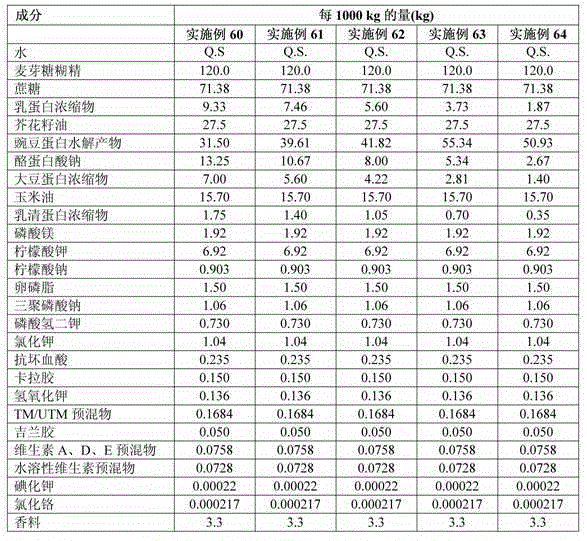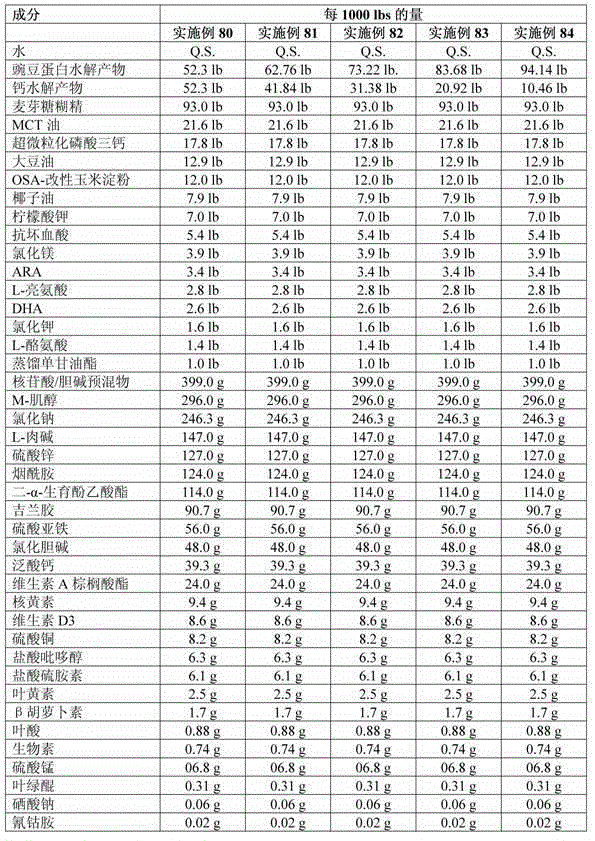Nutritional products having improved organoleptic properties
A product, nutritional technology, applied in the field of nutritional products
- Summary
- Abstract
- Description
- Claims
- Application Information
AI Technical Summary
Problems solved by technology
Method used
Image
Examples
Embodiment 1
[0148] In this example, 10 samples of filtered (F) and non-filtered (N) pea protein hydrolyzate prepared according to the method as described herein were evaluated and compared to whole pea protein isolate (ISO) samples Various physical characteristics. Filtered (F) indicates that the sample was subjected to the second filtration step described above. All samples were subjected to the first filtration step described above. The control sample (intact) was not subjected to any hydrolysis procedure. Specifically, the samples were evaluated for degree of hydrolysis, molecular weight distribution, isoflavone content, and phytate content using standard analytical techniques. The evaluation results are shown in the table below.
[0149]
Embodiment 2
[0151] In this example, the hypoallergenic potential of the pea protein hydrolyzate analyzed in Example 1 was assessed and rabbit hyperimmunization was used (in which rabbits were immunized multiple times over a period of 35 days as described below) ) compared with the whole pea protein isolate (ISO) sample of Example 1. The immunogenicity of the pea protein hydrolyzate was subsequently tested by ELISA (enzyme-linked immunosorbent assay) which measures the antigen-specific IgG response of rabbits to the intact pea protein / pea protein hydrolyzate immunogen.
[0152] The rabbits used in this example were placed on a diet free of milk, soy and pea protein for 14 days prior to the first immunization. On day 0, the baseline antibody status of each rabbit was assessed by blood samples from the rabbits. After baseline was obtained, each rabbit was immunized with 5.0 mg pea protein equivalent amino acid content contained in 4.5 ml antigen emulsified in complete Freund's adjuvant (CFA...
Embodiment 3
[0157] In this example, the hypoallergenic potential of the pea protein hydrolyzate analyzed in Example 1 was evaluated and compared with the intact pea protein isolate (ISO) sample of Example 1 using the antigen content measured by inhibition ELISA. In this assay, intact pea protein was coated on an ELISA plate. Separately prepare incubation tubes containing samples or pea protein solution (at standard concentrations) plus anti-pea protein antibody. After the incubation period, aliquots of the sample (or standard) plus antibody solution are added to the coated plate. After incubation and washing, an anti-rabbit IgG enzyme-conjugated antibody was added. Plates were incubated, washed, and enzyme substrate added. A color reaction was performed that was inversely proportional to the concentration of pea antigen in the sample quantified based on a standard curve. The results of this test for 10 samples are shown in the table below.
[0158]
PUM
| Property | Measurement | Unit |
|---|---|---|
| molecular weight | aaaaa | aaaaa |
Abstract
Description
Claims
Application Information
 Login to View More
Login to View More - R&D
- Intellectual Property
- Life Sciences
- Materials
- Tech Scout
- Unparalleled Data Quality
- Higher Quality Content
- 60% Fewer Hallucinations
Browse by: Latest US Patents, China's latest patents, Technical Efficacy Thesaurus, Application Domain, Technology Topic, Popular Technical Reports.
© 2025 PatSnap. All rights reserved.Legal|Privacy policy|Modern Slavery Act Transparency Statement|Sitemap|About US| Contact US: help@patsnap.com



